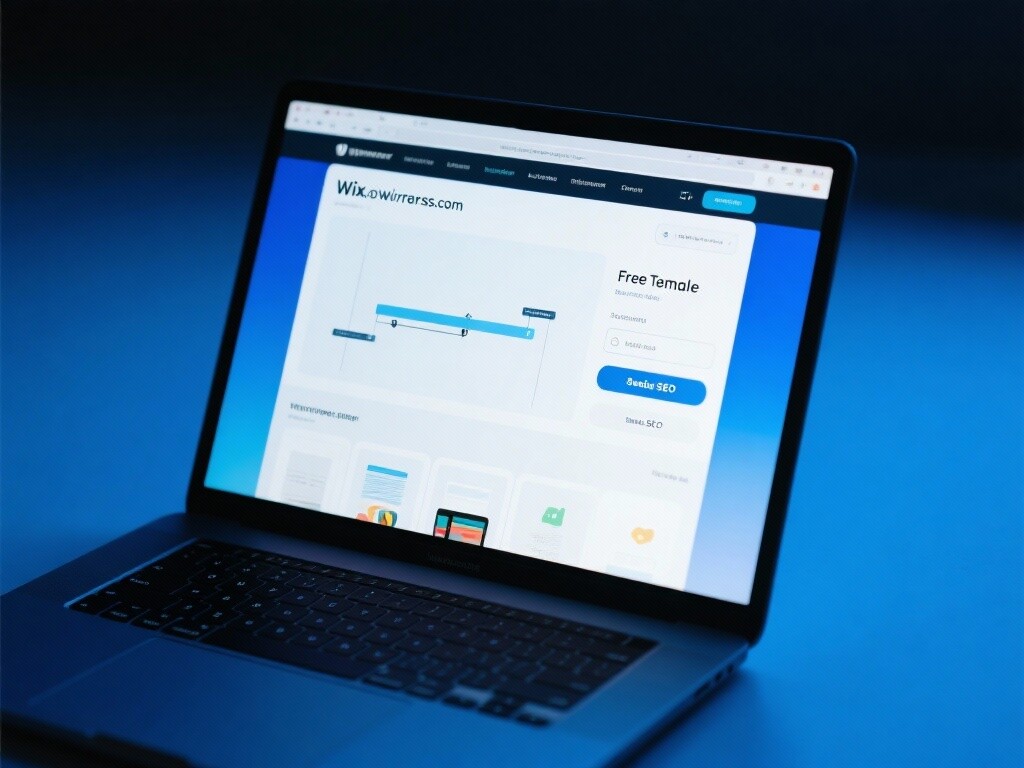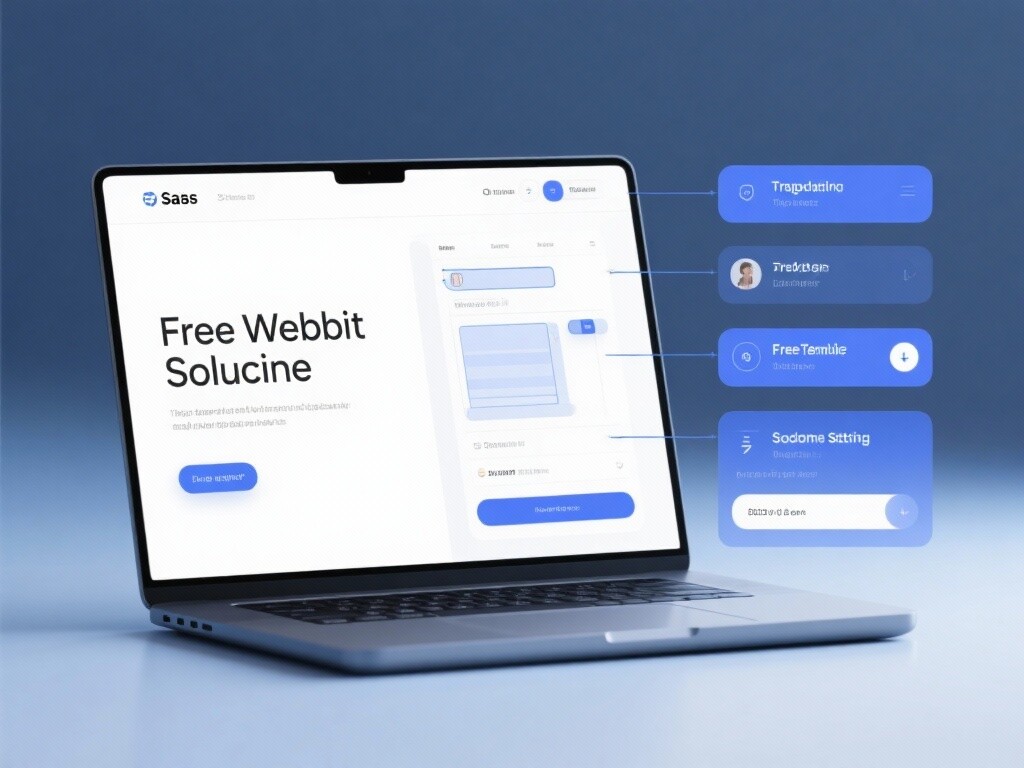Definition of Free Websites: Zero-Cost Entry-Level Digital Platforms
Free Websites (Free Website) typically refer to platforms provided by website builders (Website Builder) or open-source content management systems (CMS), allowing users to create and use online platforms without paying for hosting fees, software licensing fees, or basic functionality fees.
Two Main Forms of Free Websites:
SaaS Platform Free Packages (Most Common):
Features: Provided by platforms like Wix, Weebly, and WordPress.com. Users utilize the platform's subdomains (e.g.,
yourname.wixsite.com).Revenue Model: Monetized through platform ads on the website, restricted advanced features, and **paid upgrades to premium packages (removing ads, using custom domains)**.
Open-Source CMS Self-Hosting:
Features: Built using open-source CMS like WordPress.org or Joomla. The software itself is free, but users must cover server (Hosting) and domain (Domain) fees.
Core: Here, "free" primarily refers to free software usage rights.
This topic page focuses on SaaS platform free website models because they truly achieve zero initial costs.
Typical Limitations of Free Websites:
Ads: The bottom or top of the website usually displays the platform's logo and ads.
Domain: Must use the platform's subdomains (e.g.,
example.platform.com).Functionality: Features like storage space, bandwidth, plugin installation, advanced SEO settings are often strictly limited.
Code/Data: Lack full control over underlying code and data.
History of Free Websites: From Personal Homepages to Business Testing Grounds
The evolution of free websites reflects the democratization of internet technology and content creation:
1. Early Stage: Geocities and Personal Homepages (1990s-2005)
Features: Represented by Geocities and Angelfire, offering simple HTML editors and limited free space.
Application: Mainly used for personal interest showcases, fan sites, simple online diaries. Functionality was very basic, lacking commercial value.
2. The Rise of the Blog Era (2003-2010):
Tech-Driven: The popularity of blogging platforms like WordPress.com and Blogger.
Impact: Made content creation unprecedentedly simple, "free websites" became closely tied to content publishing. Individuals and journalists began using free platforms as primary channels for content dissemination.
3. The Explosion and Commercialization of SaaS Website Builders (2010-Present):
Core Shift: The maturity of visual SaaS website builders like Wix, Weebly, and Squarespace. They offered drag-and-drop interfaces and professional templates.
Commercial Application: Free websites were no longer just personal homepages but became quick-start tools for small e-commerce, startup showcases, and freelancer portfolios.
Trend: Platforms attract users through free trials, then monetize via premium packages offering custom domains, ad-free experiences, and advanced SEO features, guiding users toward professional paid services.
Technical Principles of Free Websites: Subdomains and Shared Resource Hosting
The zero-cost operation of free websites relies on platforms' centralized, shared technical hosting and resource allocation strategies.

1. Shared Resources and Centralized Hosting
Principle: Data and code from thousands of free websites are hosted on the platform's shared server clusters.
Resource Limits: Platforms control total costs by restricting bandwidth (traffic), storage space, and CPU usage per free website. If a site exceeds traffic limits, users are prompted to upgrade.
2. Subdomains and Brand Isolation
Principle: Free websites must use the platform's subdomains, e.g.,
blog.wix.comorshop.shopify.com.SEO Impact: For SEO, subdomain authority primarily belongs to the main domain (the platform). This makes it difficult for free websites to establish independent authority and rankings for competitive keywords.
3. Ad Embedding and Code Locking
Principle: Platforms monetize by forcibly embedding ad codes and platform links in free users' code.
Technical Restrictions: To prevent ad removal or advanced optimizations, free packages typically disallow access or modifications to HTML/CSS code and restrict third-party advanced plugins (e.g., complex SEO tools).
4. Security and Maintenance
Principle: Complex maintenance tasks like security updates, SSL certificate deployment, and DDoS protection are entirely handled by the platform.
Advantage: This is the biggest technical benefit of free websites—users don’t need to worry about technical maintenance or security issues.
Technical Features and Core Value Propositions of Free Websites
Free websites are ideal for specific stages and needs, but their limitations also set the stage for future professional development.
1. Extremely Low Barrier and Quick Launch
Features: Drag-and-drop interfaces, zero coding required.
Value: Suitable for tech novices, personal resumes, event landing pages, or MVPs (Minimum Viable Products) to validate business ideas. Can go live within hours.
2. Professionally Designed Templates
Features: Platforms offer a wide range of templates designed by professional designers.
Value: Even free websites can maintain professional visual standards, avoiding the amateurish feel of traditional self-built sites.
3. Built-In Basic SEO Features
Features: Basic functionalities usually allow setting page titles (Title Tag) and meta descriptions (Meta Description).
Value: Enables basic page optimizations, ensuring the site is correctly indexed by search engines. However, lacks advanced SEO tools (e.g., structured data, caching optimizations).
4. Hidden SEO Limitations and Brand Risks
Features: Use of subdomains, bandwidth restrictions, and forced ads.
Risks:
Brand Professionalism Erosion: Ads and non-custom domains weaken brand professionalism and credibility.
Traffic Bottlenecks: Due to subdomain limitations and lack of advanced SEO configurations, free websites struggle to rank for competitive keywords, easily hitting traffic ceilings.
Low Conversion Rates: Forced ads and slow loading (due to shared hosting) disrupt user experience, lowering conversions.
Advanced Applications and Professional Upgrade Recommendations for Free Websites
Seasoned SEO experts recommend treating free websites as**"launch tools" rather than "long-term assets"**, planning upgrade paths early.

1. Best Use Cases for Free Websites
Personal/Portfolio Showcases: Quickly display personal resumes, design works, or photography portfolios.
Event Landing Pages: Short-term event or seminar sign-up pages.
Product MVPs: Validate market acceptance of new products or services, collecting early feedback.
Non-Profit Organizations: Low-budget information dissemination and basic donation channels.
2. SEO Strategy: Focus on Long-Tail and Brand Keywords
Due to free websites' authority limitations, adjust SEO strategies to:
Focus on Long-Tail Keywords: Create highly niche, low-search but intent-precise long-tail content.
Optimize Brand Keywords: Ensure your site ranks first when users search for your brand name.
Content is King: Leverage free websites' publishing features to consistently release high-quality, valuable content, accumulating content assets for future paid upgrades.
3. Necessity and Roadmap for Professional Upgrades
When your business becomes profitable or traffic demands grow, upgrading to paid plans is essential:
EasyYun Recommendations: For long-term brand building and SEO traffic accumulation, professional paid websites are the only viable strategy.
EasyYun: Your Website Health Diagnostics and Upgrade Navigation Expert
EasyYun not only provides professional SEO services but also helps you scientifically plan transitions from free to high-conversion professional websites.
Free Website SEO Health Diagnostics: Assess your free website’s current technical SEO limitations, content structure, and keyword coverage, offering suggestions to maximize free traffic.
Traffic and Cost-Benefit Analysis: Help calculate breakeven points (Breakeven Point) for upgrading to paid packages, ensuring investments are justified.
Professional Website Platform Selection: Based on your business type, technical capabilities, and budget, recommend the best **SaaS (e.g., Shopify) or open-source CMS (e.g., WordPress)** solutions.
Data Migration and Seamless SEO Transition: Ensure all old links are perfectly redirected via 301 when switching from free subdomains to custom domains, avoiding traffic loss.
Choose EasyYun to turn your free website into a short-term yet highly efficient testing ground, while planning a data-assetized, high-conversion professional upgrade path.
FAQ
1. Can free websites achieve SEO rankings?
Yes, but with limited potential and high difficulty.
Possible: You can optimize page titles and meta descriptions, focusing on extremely long-tail keywords to ensure your content gets indexed.
Limitations: Due to low subdomain authority, lack of advanced SEO features (such as structured data and custom code), and forced ads compromising user experience, it's nearly impossible to rank highly for competitive core keywords. Free websites primarily rank for brand terms and ultra-low-competition long-tail keywords.
2. What are the key commercial differences between free and paid websites?
The core distinctions lie in professionalism and data assets:
Professionalism: Paid websites use independent domains with no ads, enabling professional branding and user trust, resulting in higher conversion rates.
Data assets: Paid websites grant ownership of independent domains as digital assets, plus full control over client data and marketing tools (e.g., Google Analytics, Facebook Pixel) for precise attribution and remarketing.

Customer Reviews
Mr. Chen, Founder of a Design Studio
"With EasyWin's guidance, we initially used a free website to showcase our portfolio. They taught us to focus on high-intent long-tail keyword optimization while leveraging the free blog feature for consistent content publishing. The result? Zero-cost client acquisition and early feedback. When we became profitable, EasyWin designed a seamless migration to a paid standalone domain, preserving all link equity and preventing traffic loss. Free sites are door-openers, but EasyWin's planning was our success guarantee."
Ms. Liu, an Online Course Developer
"I initially published courses on free platforms but struggled with disruptive ads and non-independent domains, which felt unprofessional. EasyWin analyzed the ROI of upgrading and recommended a paid SaaS platform with built-in SEO-friendly themes. Post-upgrade, my site speed and professionalism improved immediately, with inquiry conversions rising 30%. I realized free sites save money but cost more in brand equity and lost traffic."
![Website Filing Services: Quick Approval Tips Website Filing Services: Quick Approval Tips]() Website Filing Services: Quick Approval TipsAddressing pain points for foreign trade website filing, detailing 7 key techniques for material preparation, domain selection, and server configuration. Integrated with AI pre-approval system to achieve 3-day fast approval.
Website Filing Services: Quick Approval TipsAddressing pain points for foreign trade website filing, detailing 7 key techniques for material preparation, domain selection, and server configuration. Integrated with AI pre-approval system to achieve 3-day fast approval.![Foreign Trade Marketing Solutions: From 0 to 100 Breakthrough Foreign Trade Marketing Solutions: From 0 to 100 Breakthrough]() Foreign Trade Marketing Solutions: From 0 to 100 BreakthroughEasyWin leverages AI and big data technologies to provide an all-in-one solution from building independent foreign trade websites to global marketing promotion, helping export enterprises quickly enter international markets and achieve efficient conversion and brand growth.
Foreign Trade Marketing Solutions: From 0 to 100 BreakthroughEasyWin leverages AI and big data technologies to provide an all-in-one solution from building independent foreign trade websites to global marketing promotion, helping export enterprises quickly enter international markets and achieve efficient conversion and brand growth.![Still struggling with foreign trade website traffic? This fast SEO tool helps you effortlessly boost your rankings Still struggling with foreign trade website traffic? This fast SEO tool helps you effortlessly boost your rankings]() Still struggling with foreign trade website traffic? This fast SEO tool helps you effortlessly boost your rankingsDiscover how EasyOperate AI marketing platform solves foreign trade website traffic challenges through rapid SEO tools, including independent site construction, AI optimization technology, and success cases, helping foreign trade enterprises achieve efficient customer acquisition.
Still struggling with foreign trade website traffic? This fast SEO tool helps you effortlessly boost your rankingsDiscover how EasyOperate AI marketing platform solves foreign trade website traffic challenges through rapid SEO tools, including independent site construction, AI optimization technology, and success cases, helping foreign trade enterprises achieve efficient customer acquisition.![Must-Know for Multilingual Foreign Trade Website: 5 Key Metrics for Website Testing Must-Know for Multilingual Foreign Trade Website: 5 Key Metrics for Website Testing]() Must-Know for Multilingual Foreign Trade Website: 5 Key Metrics for Website TestingThis article systematically analyzes the 5 essential testing metrics for multilingual foreign trade websites, including SEO architecture scoring and multilingual compatibility from a technical perspective. With real-world case studies from EasyYunbao's AI-powered website building system, it provides actionable optimization solutions for businesses.
Must-Know for Multilingual Foreign Trade Website: 5 Key Metrics for Website TestingThis article systematically analyzes the 5 essential testing metrics for multilingual foreign trade websites, including SEO architecture scoring and multilingual compatibility from a technical perspective. With real-world case studies from EasyYunbao's AI-powered website building system, it provides actionable optimization solutions for businesses.![Poor B2B export promotion results? Try these Google SEO-certified optimization techniques! Poor B2B export promotion results? Try these Google SEO-certified optimization techniques!]() Poor B2B export promotion results? Try these Google SEO-certified optimization techniques!Addressing the pain points of ineffective promotion for B2B export enterprises, this article provides Google-certified SEO optimization techniques, covering multilingual website construction, integrated SEO+SEM strategies, and smart detection tool applications to help improve overseas promotion ROI.
Poor B2B export promotion results? Try these Google SEO-certified optimization techniques!Addressing the pain points of ineffective promotion for B2B export enterprises, this article provides Google-certified SEO optimization techniques, covering multilingual website construction, integrated SEO+SEM strategies, and smart detection tool applications to help improve overseas promotion ROI.![Is Your Foreign Trade Website a Profit Generator? Decoding the 3 Core Functions Is Your Foreign Trade Website a Profit Generator? Decoding the 3 Core Functions]() Is Your Foreign Trade Website a Profit Generator? Decoding the 3 Core FunctionsRevealing the 3 Core Functions of a Foreign Trade Website: Global CDN Acceleration for 2-Second Loading, AI Multilingual Auto-Adaptation Covering 249 Languages, Enterprise-Grade Security to Ensure Transaction Safety—Transforming Websites into High-Efficiency Customer Acquisition Tools.
Is Your Foreign Trade Website a Profit Generator? Decoding the 3 Core FunctionsRevealing the 3 Core Functions of a Foreign Trade Website: Global CDN Acceleration for 2-Second Loading, AI Multilingual Auto-Adaptation Covering 249 Languages, Enterprise-Grade Security to Ensure Transaction Safety—Transforming Websites into High-Efficiency Customer Acquisition Tools.![Multilingual Foreign Trade Website Construction – The Golden Key to Unlocking Global Markets Multilingual Foreign Trade Website Construction – The Golden Key to Unlocking Global Markets]() Multilingual Foreign Trade Website Construction – The Golden Key to Unlocking Global MarketsEasyTrade's intelligent website system supports multilingual standalone site building, integrating AI translation with SEO optimization to help Chinese semi-trailer manufacturing enterprises efficiently develop markets under the Belt and Road initiative, achieving dual breakthroughs in B2B foreign trade promotion and Google SEO certification optimization.
Multilingual Foreign Trade Website Construction – The Golden Key to Unlocking Global MarketsEasyTrade's intelligent website system supports multilingual standalone site building, integrating AI translation with SEO optimization to help Chinese semi-trailer manufacturing enterprises efficiently develop markets under the Belt and Road initiative, achieving dual breakthroughs in B2B foreign trade promotion and Google SEO certification optimization.![Website Testing Tools Recommendation: Boost Foreign Trade Website Conversion Rate Website Testing Tools Recommendation: Boost Foreign Trade Website Conversion Rate]() Website Testing Tools Recommendation: Boost Foreign Trade Website Conversion RateThis article details a comparison of features and application scenarios for 5 professional website testing tools, combined with real-world B2B international trade promotion cases. It analyzes how to improve multilingual standalone websites' Google SEO scores and conversion rates through technical means, particularly suitable for Belt and Road market expansion needs.
Website Testing Tools Recommendation: Boost Foreign Trade Website Conversion RateThis article details a comparison of features and application scenarios for 5 professional website testing tools, combined with real-world B2B international trade promotion cases. It analyzes how to improve multilingual standalone websites' Google SEO scores and conversion rates through technical means, particularly suitable for Belt and Road market expansion needs.
![SSL Certificate SSL Certificate]() SSL CertificateEasy Treasure provides professional SSL certificate services, including single-domain and wildcard certificates, ensuring encrypted website data transmission, identity verification, and integrity protection, helping businesses establish a secure and trustworthy online business environment.
SSL CertificateEasy Treasure provides professional SSL certificate services, including single-domain and wildcard certificates, ensuring encrypted website data transmission, identity verification, and integrity protection, helping businesses establish a secure and trustworthy online business environment.![EYB AMP/MIP Mobile Intelligent Building Station EYB AMP/MIP Mobile Intelligent Building Station]() EYB AMP/MIP Mobile Intelligent Building StationEYB Mobile Dual Engine Standalone System supports independent creation of Google AMP multilingual mobile website and Baidu MIP Chinese mobile website, which achieves millisecond loading through Google and Baidu official acceleration technology to improve search rankings and conversion rate, covering the world's two major mobile search ecosystems.
EYB AMP/MIP Mobile Intelligent Building StationEYB Mobile Dual Engine Standalone System supports independent creation of Google AMP multilingual mobile website and Baidu MIP Chinese mobile website, which achieves millisecond loading through Google and Baidu official acceleration technology to improve search rankings and conversion rate, covering the world's two major mobile search ecosystems.














